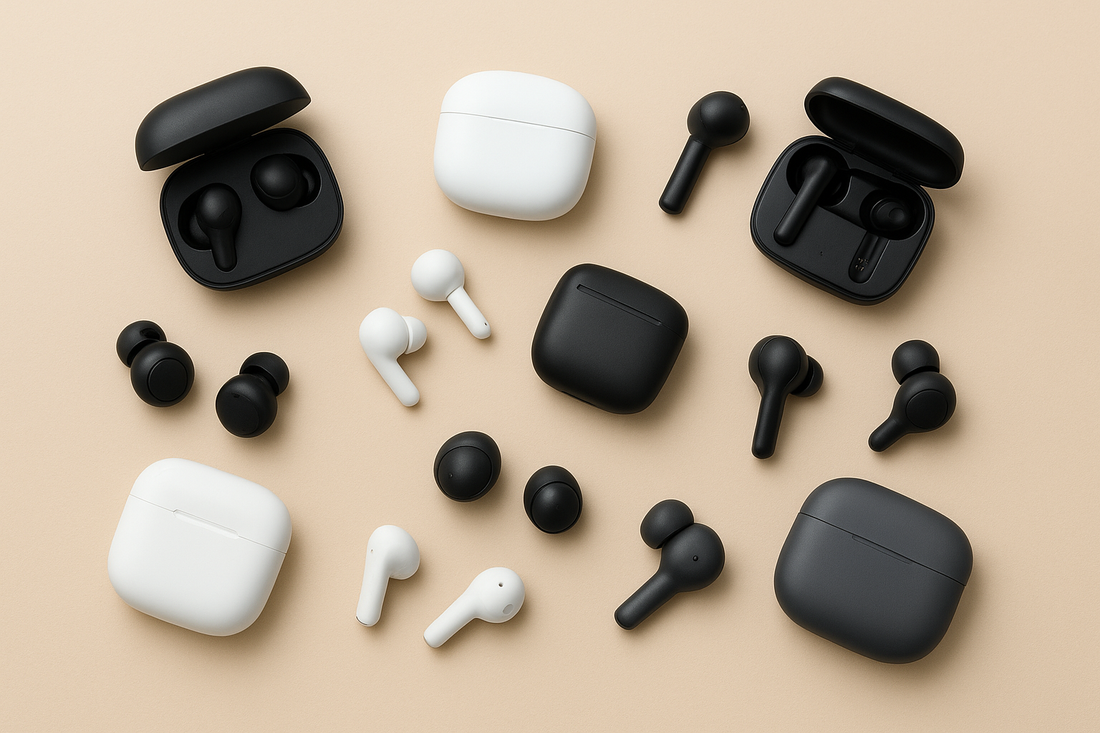
Best Budget Wireless Earbuds for Small Ears 2025
Share
If you’ve ever tried to use a pair of wireless earbuds only to have them slip out or feel uncomfortable after ten minutes, you know the frustration. Finding earbuds that fit small ears well has always been tricky. But in 2025 the options are better than ever. Brands are paying attention to different ear shapes, offering smaller tips, compact designs, and lighter builds that make a huge difference. When you’re shopping on a tighter budget, these small design details become big wins. Because what good is sound quality if the earbuds keep falling out or hurt your ears?
This article will help you figure out how to pick earbuds that actually stay in, feel good, and sound great, without costing a fortune. You’ll learn what to look for, what features matter most for comfort and fit, and I’ll show some of the best budget wireless earbuds for small ears you can get in 2025.
What Makes Earbuds Work for Small Ears
When we talk about earbuds that fit small ears, there are a few crucial characteristics. First is the tip size. Many earbuds come with multiple sizes, but even so, the smallest tip still might be too large for someone with a narrow ear canal. The material matters too; softer silicone or memory foam can conform better. The body shape of the bud is important: shorter stems or minimal protrusion make a difference. A bulky design might feel less “in” and more like it’s being pulled out by every movement.
Beyond fit, weight plays a big role. If each bud is heavy, your ear feels the pull over time. Also, the seal is vital for both sound quality and passive noise isolation. A good seal blocks external noise, improves bass response, and means you don’t have to crank volume. So when you compare earbuds, try different tip materials, test smaller sizes, and check what case weight and bud weight are. All those fine details that don’t seem like much can set apart something you use all day from something you ditch after a week.
What to Prioritize When Buying Budget Wireless Earbuds for Small Ears
When price matters (which it usually does), you want to spend your money where it counts. So deciding what features to prioritize is key. If fit and comfort aren’t right, even expensive earbuds won’t be satisfying. But if you get those right, then sound, battery life, durability, and extra touches become the icing on the cake.
Start with tip options. The ability to swap in smaller tips is non-negotiable for many people with small ears. Second, look for low-profile casing—something that doesn’t jut out of your ear. Third is build and materials: earbuds that press too much or are rigid will hurt. Fourth, sound profile matters: you may want more mid and treble clarity because bass often suffers with smaller drivers or weaker seals. Fifth, battery life should be enough for your routine—if you commute, do long listening sessions, or travel, you’ll want something that lasts. Sixth, durability—water resistance, sweat resistance, and a solid charging case make them usable in more situations.
Real-World Comfort: Why Some Buds Win
Comfort isn’t theoretical. I remember this one pair I tried that sounded amazing in specs. Deep bass, strong battery, good range. But the buds were long and protruded so much that every time I leaned back I felt them rubbing on my ear, and every time I got up they kept slipping. After an hour, I just stopped wearing them.
Then I tried another pair with compact “bean” shapes and tiny tips; they sealed well, weight felt negligible, and I didn’t have to adjust once. The sound wasn’t earth-shattering, but connection stayed strong, call quality was okay, and I wore them for hours without discomfort. That’s the kind of trade-off people with small ears often deal with—sacrificing something small to gain comfort, because comfort enables long-term use.
Best Budget Wireless Earbuds for Small Ears You Can Buy Now
Here are some strong picks in 2025 if you want earbuds that are compact, well-built, and affordable. These are solid options so you can compare features, feel, and price.
JLab JBuds Mini True Wireless Earbuds
These are made with small ears in mind. The casing is tiny and the “mini” in the name isn’t just marketing. They come with several small tips and because they’re light, many people barely notice them once they snap in. The battery run time per charge is modest, but good for short sessions, commuting, or walking. If you want something that almost disappears in your ears while still giving decent sound, these are one of the top choices.
Sony WF-C510 Wireless Headphones
Sony has always done good smaller models and this one is no exception. They offer multiple tip sizes and their sound signature favours clarity in mids, which helps when the bass can’t be super loud due to smaller drivers or less seal. The case isn’t massive, so portability is strong. You won’t get premium features like high-end ANC but you pay much less.
Xiaomi Redmi Buds 6 Play
If you’re really budget-conscious, this one is appealing. The tips are smaller options, and the buds are reasonably lightweight. Build quality is good for the price point, though you’ll want to check fit because every person’s ear is a little different. Expect lower low-end bass and more focus on mids and highs.
JLab Go Air Pop True Wireless
These are more about style and value. Very affordable, decent sound, more minimal in features. Because they are smaller, comfort is actually quite good if you use small tips. They don’t seal super tightly for deep bass, but the lightweight feel means less fatigue.
Belkin SoundForm Bolt Wireless Earbuds
Slightly more premium touches for what you pay. The case design, touch controls, and water resistance are better than some super cheap models. For small ears, the shape is more tapered, helps reduce protrusion, and the tips are comfortable enough. Again, soundwise good enough for everyday music, calls, and commuting.
Invisible Mini Wireless Earbuds
If you really want something discreet, these are your stealth pair. They’re low profile, designed to sink into the ear slightly so they’re less visible. Not the loudest or richest sound, but for background listening, podcasts, travel, or work—perfect. Because of the low profile, sealing can be tricky so picking the right tip is crucial.
Features to Inspect Before Buying
When you shortlist a pair, try them out if you can. Fit them in your ears. Jog in place. Shake your head. If they fall out, they’re not right for small ears. If they exert pressure, they’ll hurt eventually.
Check how many tip sizes are included. Some brands offer XS or extra-small tips; those are golden. Also note whether the bud is long or stubby; shorter stems or no stem options are better for small ears.
Take note of total weight—earbuds plus case. A lighter case means more likely you carry them all the time, toss them in bags, pockets, and not dread the bulk.
Look for decent battery life. Even small buds should ideally give several hours of continuous playback plus a case that adds more. If you’re using them for commuting, calls, or classes, you want it to last through those sessions.
Evaluate sound profile. Since smaller ears often get weaker bass due to imperfect seals or smaller drivers, decent mids and clean treble matter. Some earbuds let you EQ via app, which can help compensate.
Check durability. Water or sweat resistance is helpful especially if you move around, travel, or use during workouts. IP ratings like IPX4 or IPX5 are good to look for.
Common Trade-Offs with Smaller Earbuds
There are trade-offs you’ll often face, and knowing them helps set expectations so you’re not disappointed.
One common issue is bass performance. Smaller driver units and seal issues often lead to bass that’s less booming than you might hear in larger or premium earbuds. That doesn’t mean “bad sound,” it just means sound that favours clarity and comfort over chest-thumping lows.
Another trade-off is battery size. Because small earbuds pack smaller batteries, they often provide fewer hours per charge. The case helps, but every time you make the case tiny, its capacity drops. So you might get two or three hours of listening from some pairs before needing the case, whereas bigger models might double that.
Fit is a double-edge sword. Because the casing is smaller, sometimes the design sacrifices other features like multiple microphones, strong passive noise isolation, or physical controls. Touch panels might be smaller and more awkward to press, or audio features like ANC might be less powerful.
You also might find the charging cases aren’t as rugged. Very small cases tend to be made of lighter plastic, less robust hinges, fewer fancy features. If you throw them in pockets or bags, expect some wear over time.
How to Get the Most Out of Your Smaller Earbuds
Once you pick earbuds you like, there are a few tricks that help them perform better and stay comfortable for longer. Rotate the tips: sometimes swapping out foam or different silicone shapes can greatly improve seal and comfort. Clean them often—earwax builds up, which reduces sound and airflow. Charge them properly and not always try to drain them fully—short frequent charges are okay.
For those earbuds with companion apps, go in and tweak EQ settings. Sometimes lowering bass a bit or boosting mids helps avoid the muffled feel that comes from poor seal. Always carry a small case or pouch so the case and buds are protected against drops or scratching.
If you use them during workouts or outdoors, dry them after use. Sweat damages small components over time. If water resistance is specified, check it. It helps extend lifespan.
Final Thoughts
Finding budget wireless earbuds for small ears isn’t about getting everything—it’s about getting what matters most: fit, comfort, and sound good enough. The picks above strike strong balances and are more than usable in real life, not just specs on a box. When you find the pair that stays put, doesn’t hurt, and sounds good, you’ll wear them more, use them more, and get more value.
So pick a model that fits your budget, try to test fit if possible, and don’t expect every feature you see to be perfect. But with the options available in 2025, hearing clearly, comfortably, and affordably is absolutely within reach.
If you have tried any of the models I mentioned (or others) and want to share what worked or what didn’t for your ears, drop your thoughts in the comments. Hearing other small-ear folks’ experiences helps everyone make better choices.
